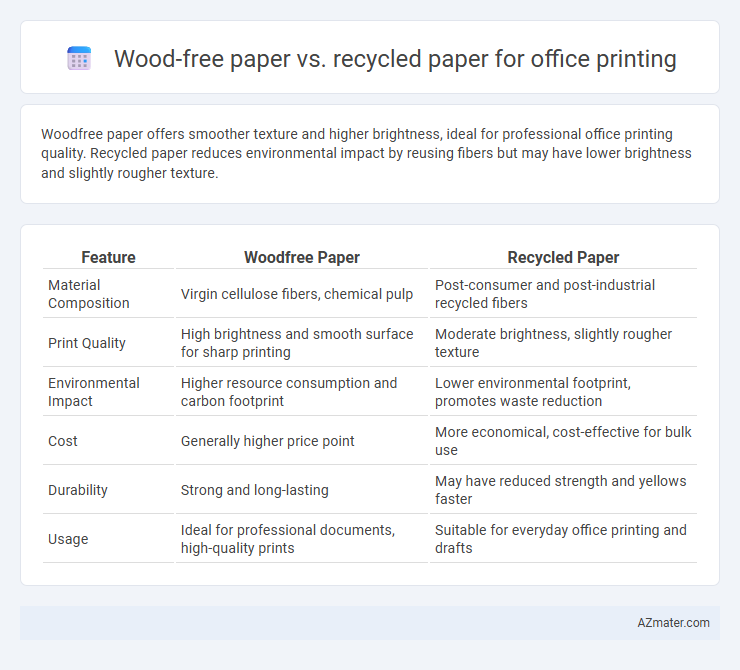Woodfree paper offers smoother texture and higher brightness, ideal for professional office printing quality. Recycled paper reduces environmental impact by reusing fibers but may have lower brightness and slightly rougher texture.
Table of Comparison
| Feature | Woodfree Paper | Recycled Paper |
|---|---|---|
| Material Composition | Virgin cellulose fibers, chemical pulp | Post-consumer and post-industrial recycled fibers |
| Print Quality | High brightness and smooth surface for sharp printing | Moderate brightness, slightly rougher texture |
| Environmental Impact | Higher resource consumption and carbon footprint | Lower environmental footprint, promotes waste reduction |
| Cost | Generally higher price point | More economical, cost-effective for bulk use |
| Durability | Strong and long-lasting | May have reduced strength and yellows faster |
| Usage | Ideal for professional documents, high-quality prints | Suitable for everyday office printing and drafts |
Understanding Woodfree Paper: Definition and Composition
Woodfree paper, primarily made from chemical pulp with lignin removed, offers a smoother finish and greater durability, making it ideal for high-quality office printing. Unlike recycled paper, which contains a mix of recovered fibers and may have a lower brightness and strength, woodfree paper ensures consistent print clarity and sharpness, essential for professional documents. Its composition reduces impurities, resulting in less dust and ink absorption, enhancing printer longevity and output quality.
What is Recycled Paper? Key Characteristics
Recycled paper is made from reclaimed paper fibers collected from used paper products, reducing the need for virgin pulp and conserving natural resources. Key characteristics include a slightly lower brightness compared to woodfree paper, a textured surface, and potential variations in color due to mixed fiber content. It offers an eco-friendly option for office printing, balancing quality with sustainability by minimizing environmental impact through reduced deforestation and waste.
Environmental Impact: Woodfree vs Recycled Paper
Woodfree paper, made primarily from chemically treated wood pulp, requires significant energy and chemicals in production, resulting in a higher environmental footprint compared to recycled paper. Recycled paper uses post-consumer waste, reducing deforestation and minimizing landfill waste, thereby conserving natural resources and lowering greenhouse gas emissions. Selecting recycled paper for office printing supports sustainable practices by promoting resource efficiency and reducing pollution.
Print Quality Comparison: Woodfree and Recycled Options
Woodfree paper delivers superior print quality with higher brightness, smoother surface texture, and better ink absorption, resulting in sharper and more vibrant office documents. Recycled paper generally has a lower brightness level and a slightly rougher texture, which can cause less crisp text and muted colors in printed materials. For professional office printing where clarity and presentation matter, woodfree paper provides a clearer and more polished finish compared to recycled alternatives.
Cost Differences: Woodfree Paper vs Recycled Paper
Woodfree paper generally has a higher production cost due to the use of virgin fibers and more intensive bleaching processes, leading to a higher price compared to recycled paper. Recycled paper, made from post-consumer waste, typically offers cost savings, making it a budget-friendly option for office printing while also reducing environmental impact. However, the price gap may vary depending on the grade, quality, and supplier, with recycled paper sometimes showing comparable durability and print quality to woodfree paper.
Compatibility with Office Printers
Woodfree paper offers superior compatibility with a wide range of office printers, including laser and inkjet models, due to its smooth texture and consistent quality that reduces paper jams and enhances print clarity. Recycled paper, while more eco-friendly, can vary in texture and fiber quality, occasionally causing feed issues or uneven ink absorption in some high-speed or precision printers. Selecting woodfree paper ensures reliable performance and professional print results, whereas recycled paper requires careful matching with printer specifications to maintain efficiency and output quality.
Sustainability Certifications and Standards
Woodfree paper for office printing often carries sustainability certifications such as FSC (Forest Stewardship Council) and PEFC (Programme for the Endorsement of Forest Certification), ensuring responsible forest management and reduced environmental impact. Recycled paper typically meets standards like Blue Angel and EU Ecolabel, highlighting its lower consumption of raw wood fibers and reduced carbon footprint through the reuse of post-consumer materials. Both paper types contribute to sustainable office practices, with certifications playing a critical role in verifying eco-friendly sourcing and production processes.
Durability and Longevity: Which Paper Lasts Longer?
Woodfree paper, made from chemically treated wood pulp, generally offers superior durability and longevity compared to recycled paper due to its higher fiber quality and resistance to yellowing over time. Recycled paper, although environmentally friendly, often contains shorter fibers and residual impurities that can reduce its strength and lead to faster degradation under frequent handling or exposure to light. For office printing where archival quality and long-term document preservation are critical, woodfree paper is the preferred choice for lasting durability.
Pros and Cons: Woodfree vs Recycled Paper in Offices
Woodfree paper offers superior brightness, smoothness, and printing quality, making it ideal for professional office documents requiring sharp, clear text and images. However, woodfree paper is less environmentally friendly due to its reliance on virgin fibers and chemical bleaching processes. Recycled paper reduces environmental impact by conserving resources and energy, but it may have lower brightness and a rougher texture, potentially affecting print quality and color vibrancy in office printing tasks.
Choosing the Right Paper for Your Office Needs
Woodfree paper offers high opacity, smooth surface, and excellent print quality, making it ideal for professional office documents and presentations. Recycled paper provides environmental benefits by reducing waste and conserving resources, with recent advancements improving its brightness and texture suitable for everyday printing tasks. Assess your office priorities--whether quality or sustainability--to select the most effective paper type for your printing needs.

Infographic: Woodfree paper vs Recycled paper for Office printing
 azmater.com
azmater.com